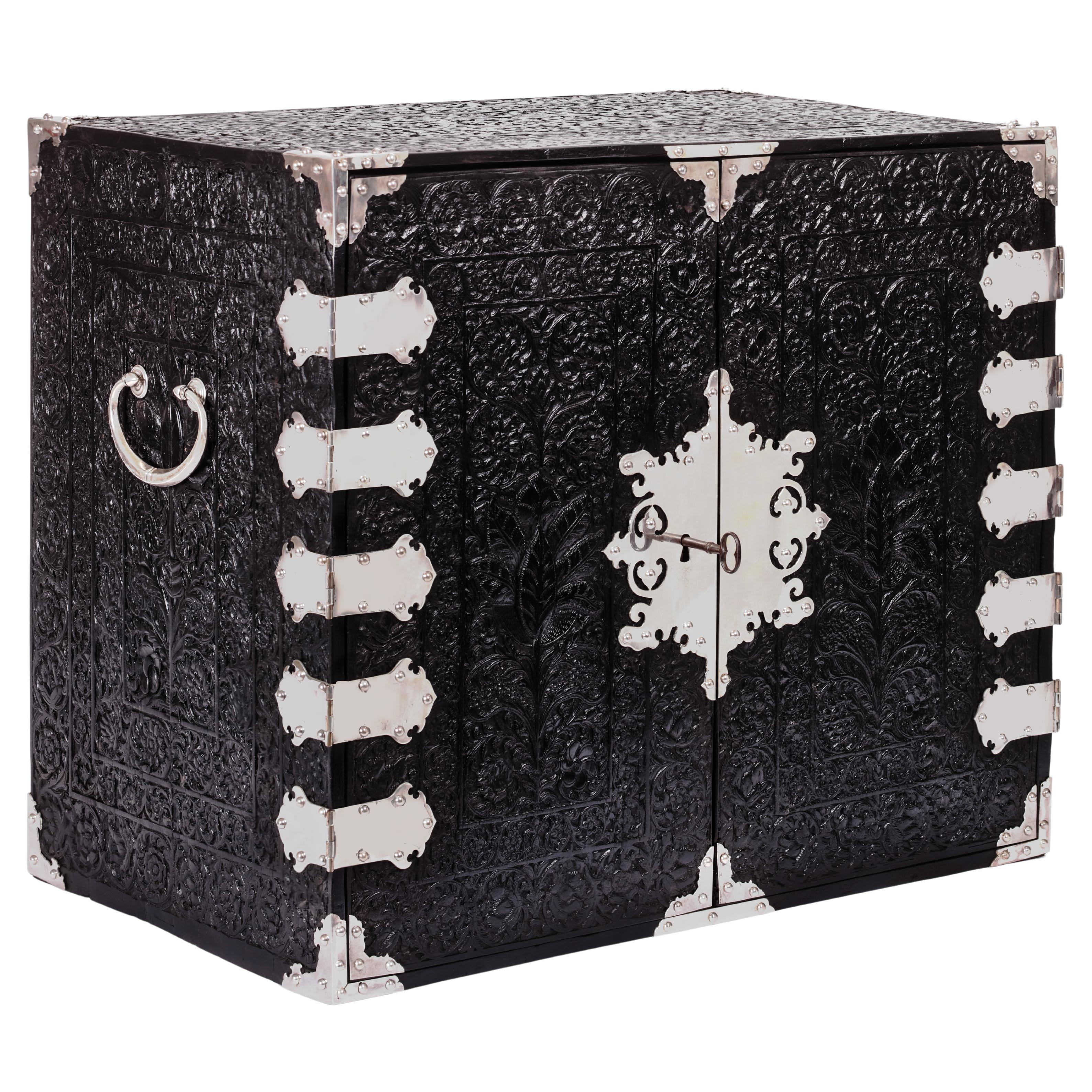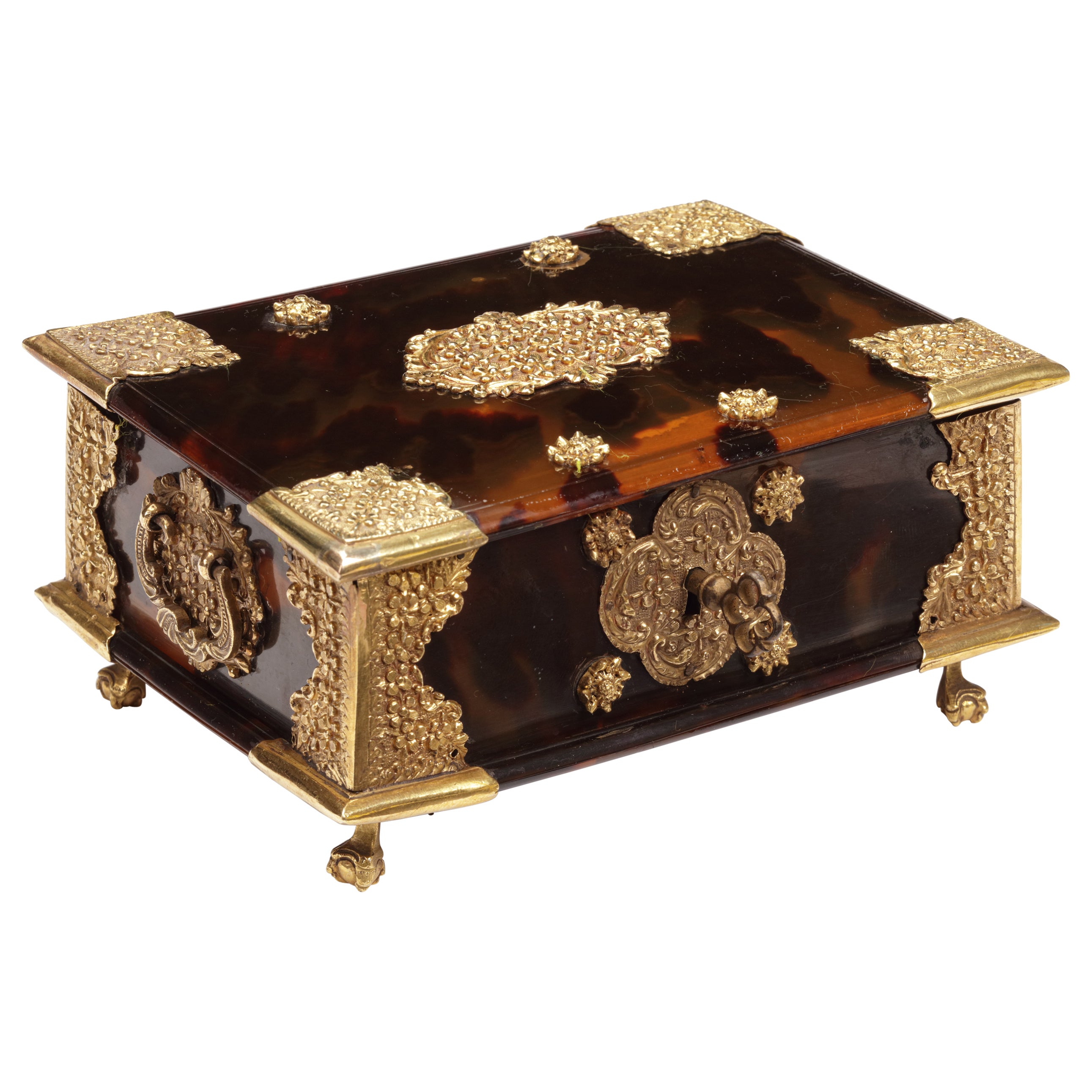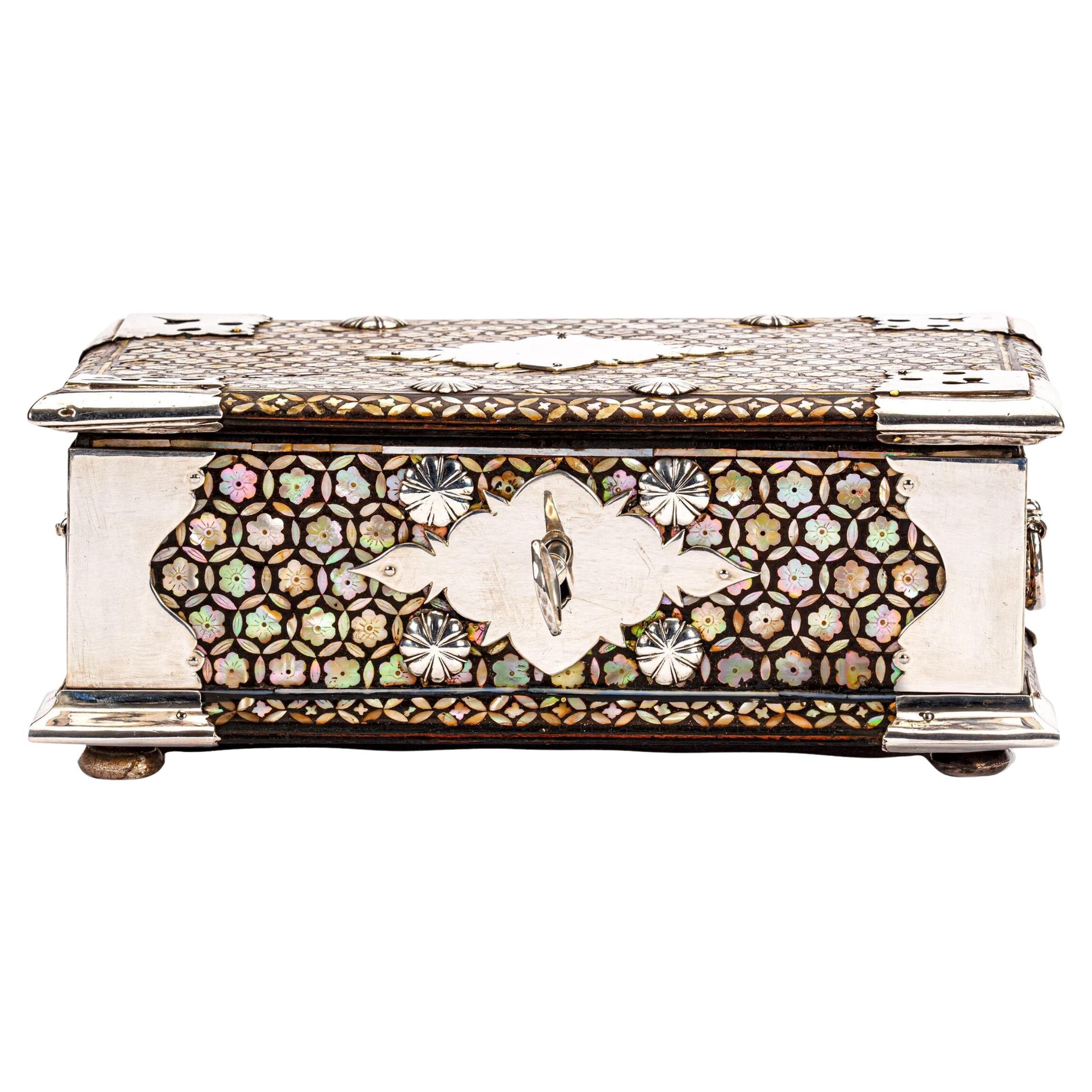Items Similar to A large Dutch colonial ebony cabinet with brass mounts
Want more images or videos?
Request additional images or videos from the seller
1 of 5
A large Dutch colonial ebony cabinet with brass mounts
About the Item
A Dutch colonial ebony cabinet with brass mounts on contemporary black steel frame
Batavia (Jakarta), 2nd half 17th century
The cabinet has two massive ebony doors opening to reveal thirteen various-sized drawers. The outside of the cabinet and the drawer fronts overall densely carved with scrolling vines and flowers. When closed, the doors show two small snakes turned away from each other in the upper center. The brass mounts probably later.
H. 80.5 x W. 91.2 x D. 54.3 cm
Provenance:
With Francesca Galloway, London
The Edith & Stuart Cary Welsh Collection
Jan Veenendaal classifies the robust carving on this cabinet as ‘Batavia Type I’. This type of decoration emerged in the period from 1680 to 1720, and features deeply carved floral motifs. Although we use the term ‘high relief’ to indicate the significant difference, ‘half relief’ would be more appropriate. A comparison could be made with Dutch and also Batavian silver, which is now adorned with deeply embossed large flowers after a period of primarily engraved decorations. In this period, the Dutch had a fondness for flowers in gardens and indoors. For example, Dirck van Ryswyck (1658 - after 1679) was known for his marquetry in touchstone. Jan van Mekeren (1658 1733) created particularly rich cabinets with marquetry on the doors in various exotic woods of vases filled with a selection
of flowers. These artists, like the VOC merchants who ordered textiles in India, had a wide choice of Dutch books with engravings of both European and exotic flowers for inspiration.
The floral motifs on the furniture arose through an interaction of Dutch and Indian artistic conceptions. Although these pieces of furniture were also found in South India and Sri Lanka, we nonetheless refer to this style as Batavian, because around 1900, when there was a lively interest in it, so many examples were found in and around this historical city. Ebony and coromandel furniture, adorned with large flowers, was used by residents of Batavia, Colombo, and the VOC settlements in South India but was only sporadically present in the Netherlands at that time. In other words: we see here a unique furniture style that originated in Asia and was beloved by the Dutch there, their Indian descendants, and wealthy Indonesians, Peranakan Chinese, and Sri Lankans (Sinhalese and Tamils). The present cabinet is a result of a unique and new style that emerged from a fusion of Asian and European ideas.
To learn more about who the furniture makers were, we must look to South India, where in the seventeenth century a continuous series of wars and famines alternated. For example, in 1661, the situation in Tanjore was so dire that the entire region was abandoned by the population. Two years later, driven by hunger, cotton painters sold themselves to the Dutch. They were mainly transported to Sri Lanka to improve the production of chintz. Although the starved Tamils were weak and carried many contagious diseases, the Dutch were the main customers of the traders in enslaved people. Craftsmen were especially welcome in Batavia and other VOC settlements.
Contemporary documents indicate that there was a large influx of enslaved people capable of making the new style of furniture in Batavia. An important point here is that craftsmen of the same profession lived in the same villages or city districts. Often, they were also from the same family. This means that furniture makers and woodcarvers lived together and that when a disaster struck their area, they all left together. In this way, an entirely new textile industry emerged in Sri Lanka due to the aforementioned exodus of textile painters. It is quite possible that an entire community of woodcarvers and furniture makers from the Kammalan caste was shipped to Batavia simultaneously. This would explain how the sudden demand in the rapidly expanding city of Batavia could be met so easily. An additional reason is that from 1657 the local industry was supported by import tariffs on household goods.
On the Coromandel Coast, beautifully carved gravestones were used to cover the graves of the Dutch. As early as the beginning of the 17th century, large gravestones were shipped from Sadraspatnam (India) to Batavia, Colombo, and the Cape (South Africa). In Sadraspatnam and Negapatnam, many of these gravestones are still in situ. In Jakarta, Colombo, and Cape Town, a number can also be found. From 1680, these gravestones were carved with a frame of flowers, some of which are the same as those on the ebony and calamander furniture from Batavia, like the present cabinet.
On the doors of the present cabinet and others alike, within an arch-shaped space, flowers are arranged on branches that seemingly sprout randomly from the base. Above the arches, two slender snakes facing each other are carved out. Snakes have a special meaning in Hindu mythology. For example, they can turn into arrows and protect their owner. In the Javanese version, they can still take revenge, even if the evil has already occurred. When the snakes face each other, they are made by an Indian craftsman. When the snakeheads are turned away from each other, the carving is done by a Javanese woodcarver. The snakes refer to Naga, the Sanskrit word for a deity or class of entity or being, taking the form of a giant snake. In Hindu religious culture, Nagas are considered nature spirits closely associated with water, rivers, lakes and seas as protectors of springs. Hence, they are regarded as protectors of valuables, which is perfect for a precious cabinet with possibly even more precious contents.
Sources:
Jan Veenendaal, Wonen op de Kaap en in Batavia 1602-1795, Titus M. Eliëns ed., Waanders, Zwolle, 2002, pp. 30- 32
Jan Veenendaal, Aziatische kunst en de Nederlandse Smaak, Waanders, Zwolle, 2014
- Dimensions:Height: 31.7 in (80.5 cm)Width: 35.91 in (91.2 cm)Depth: 21.38 in (54.3 cm)
- Style:Dutch Colonial (Of the Period)
- Materials and Techniques:
- Place of Origin:
- Period:Mid-17th Century
- Date of Manufacture:2nd half 17th century
- Condition:Wear consistent with age and use.
- Seller Location:Amsterdam, NL
- Reference Number:1stDibs: LU5458239038452
About the Seller
5.0
Vetted Seller
These experienced sellers undergo a comprehensive evaluation by our team of in-house experts.
Established in 1985
1stDibs seller since 2020
19 sales on 1stDibs
Typical response time: 3 hours
- ShippingRetrieving quote...Ships From: Amsterdam, Netherlands
- Return PolicyA return for this item may be initiated within 7 days of delivery.
More From This SellerView All
- A Dutch colonial ebony box with silver mountsLocated in Amsterdam, NLBatavia (Jakarta), or Sri Lanka, circa 1680-1720 The document or money box is densely carved with fine scrolling vines and lotus flowers. It has a charming heart- shapes silver lock...Category
Antique Late 17th Century Indonesian Dutch Colonial Antiquities
MaterialsSilver
- A 17th century Dutch-colonial ebony two-door VOC cabinet with silver mountsLocated in Amsterdam, NLA Dutch-colonial ebony two-door cabinet with silver mounts Coromandel Coast, probably Masulipatnam, circa 1650-1680, the silver later H. 64.5 x W. 75 x D. 46 cm The present cabinet...Category
Antique 17th Century Indian Dutch Colonial Antiquities
MaterialsSilver
- A small Dutch colonial Indonesian tortoiseshell betel box with gold mountsLocated in Amsterdam, NLJakarta (Batavia), 18th century, apparently unmarked L. 14 x W. 9.5 x H. 4.7 cm Before settling down to business in the former Dutch East Indies, sirih had to be offered in the mos...Category
Antique Late 18th Century Indonesian Dutch Colonial Antiquities
MaterialsGold
- 18th-century Dutch-colonial Peranakan mother-of-pearl casket with silver mountsLocated in Amsterdam, NLAn Indonesian Peranakan mother-of-pearl inlaid mastic sirih casket with silver mounts Jakarta (Batavia), circa 1720-1730, the silver hinges marked for Batavia, maker’s mark HS or SH...Category
Antique Mid-18th Century Indonesian Dutch Colonial Antiquities
MaterialsSilver
- 17th century colonial Sinhalese ebony two-door cabinet with silver mountsLocated in Amsterdam, NLA splendid Dutch-colonial Sinhalese ebony two-door cabinet with silver mounts Sri Lanka, Kandy, 2nd half 17th century, the mounts later The cabinet with a central drawer with hidde...Category
Antique 17th Century Sri Lankan Dutch Colonial Jewelry Boxes
MaterialsSilver
- Dutch-Colonial Satin and Rosewood, Ebony and Teak Collectors’ Table-CabinetLocated in Amsterdam, NLA charming satin and rosewood, ebony and teak collectors’ table-cabinet Sri Lanka, second half of the 18th century Measures: H. 86.5 x W. 62.5 x D. 34.7 cm In the top of the shaped cornice, there is a carving of a butterfly or moth. Under the cornice two panelled doors with scorched chequered motif, and under the doors one long drawer. When the doors are locked, so is the drawer. Behind the two doors, there are eight drawers, suitable to store small collectors’ items, such as a coin collection, or mineral specimens, small shells, collections of animal teeth, etc. The 17th and 18th centuries saw a wide-spread interest in exotic cultures and collecting of botanical, zoological and geological specimens...Category
Antique 18th Century Sri Lankan Dutch Colonial Cabinets
MaterialsSatinwood, Ebony, Teak
You May Also Like
- Early 20th Century Dutch Colonial CabinetLocated in New York, NYA large polychromed wood cabinet with two doors and shelves from Central Java, Indonesia, early 20th Century. Hand-carved accents, original hardware. Dimensions: 59" wide, 28" deep...Category
Vintage 1920s Javanese Dutch Colonial Cabinets
MaterialsWood
- Large Pair of Corner CabinetsLocated in Firenze, ITSplendid pair of Livorno corner cupboards from the second half of the 19th century in mahogany wood with original patina. the two corner units have tops in white Carrara marble. On the sides they have carved friezes, the lower part has two rounded doors while the upper part has a central door with glass. These two beautiful large corner cabinets...Category
Antique 19th Century Italian Furniture
MaterialsWood
- Dutch Colonial Carved Wooden Cabinet with Diamonds and Radiating MotifsLocated in Yonkers, NYA Dutch Colonial wooden cabinet from the 19th century, with carved doors, diamonds and radiating motifs. Immerse yourself in the historical depth and artistic beauty of this 19th-cen...Category
Antique 19th Century Indonesian Dutch Colonial Cabinets
MaterialsWood
- Javanese Dutch Colonial Two Part Display Corner Cabinet with Glass DoorsLocated in Yonkers, NYAn antique Javanese Dutch Colonial period two-part display corner cabinet from the early 20th century with paneled glass doors in the upper section and wooden doors in the lower one....Category
Early 20th Century Javanese Dutch Colonial Corner Cupboards
MaterialsGlass, Wood
- Dutch Colonial Early 20th Century Indonesian Display Cabinet with Carved MotifsLocated in Yonkers, NYA Dutch Colonial period Indonesian display cabinet from the early 20th century, with carved motifs, glass doors and cabriole legs. Created in Indonesia during the early years of the 20th century, this Dutch Colonial display cabinet...Category
Early 20th Century Indonesian Dutch Colonial Cabinets
MaterialsTeak, Glass
- Dutch Colonial Antique Lacquered Wood Cabinet with Glass Doors and Cabriole LegsLocated in Yonkers, NYA Dutch Colonial Indonesian antique lacquered wooden cabinet from the early 20th century, with paneled glass doors, carved apron and claw feet. Crafted during the Dutch Colonial peri...Category
Early 20th Century Indonesian Dutch Colonial Cabinets
MaterialsGlass, Wood
Recently Viewed
View AllMore Ways To Browse
Antique Hong
Dog Pottery Dynasty
Midcentury Modern Coffee Table And Side Tables
Vintage Modern Upholstered Chairs
Italian Chrome And Glass Tables
Italian Glass And Chrome Tables
Embassy Silver
Hand Painted Black Table
New Danish Dining Chairs
13 Vase
Built Ins
Vintage Corner Piece
Wood Chair Danish 1960s
Set Of Two Lights
Glass And Brass Vintage Pendant Light
Box On Feet
Vintage Table Set With Chairs
Patterned Top Side Table





